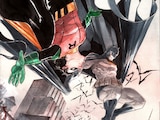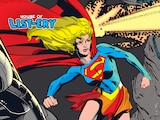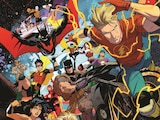
With an eagerly awaited new show premiering next week on The CW, it’s safe to say the Flash is more popular than he’s ever been before. Considering we’re talking about a character who has remained an icon of comics for over 70 years, that’s really saying something. Yet, while many people may recognize who the Flash is, the character’s world and history aren’t generally as well known as those of Superman, Batman or Wonder Woman. So to fill you in on a few of the basics, we thought we’d whip up a quick 101 on the Fastest Man Alive. Or should we say, the Fastest Men Alive.
Yes, there have been a total of four men who have wielded the mantle of the Flash since the character’s debut, and we thought we’d take a quick (this is the Flash, after all) look at them. But first, a caveat. With the possible exception of Green Lantern, the Flash has the most complex history of all of the Justice Leaguers. His stories involve traveling through time and dimensions. We’re talking about the guy who discovered the Multiverse, after all. There’s no way we’ll be able to touch on everything in a simple, straightforward blog post. Instead, we’re just going to focus on the basics, largely for the benefit of new fans. If you’re a longtime Flash reader, you probably don’t need this 101. You’re ready for the advanced class.
But for the rest, let’s start at the beginning with the very first Flash…

Jay Garrick
The Flash made his comic book debut in 1940’s FLASH COMICS #1 by writer Gardner Fox and artist Harry Lampert. Jay Garrick was a college student in Keystone City who developed incredible superspeed after he fell asleep in the science lab and accidentally inhaled the hyper-charged atoms of a radioactive liquid. He was the one and only Flash up until the mid-1950s.
Jay stands out from all of the later Flashes due to his Golden Age-era costume. With his red, lightning bolt-branded shirt, his blue and yellow pants and his distinctive silver winged helmet, he looks much, much different than his successors. He’s also the only version of the Flash to not wear a mask.
During his tenure, Jay would help form the Justice Society of America, a group with which he’s had a continued association ever since, and would serve as something of a father figure for later Flashes. While Jay traditionally appears middle-aged, chronologically he’s actually a lot older. This is the result of a few events within his life that slowed down the aging process, including a period spent in suspended animation.
In The New 52, Jay Garrick can be found in the series Earth 2, where he’s much younger and wears an updated take on Jay’s Golden Age costume.

Barry Allen
The most widely known iteration of the Flash is Barry Allen, and unsurprisingly, it’s the version that will be brought to the screen in the new CW series. Debuting in 1956’s SHOWCASE #4, written by John Broome and Robert Kanigher and drawn by the great Carmine Infantino and Joe Kubert, Barry Allen’s Flash brought new energy and relevance to the character and is largely regarded as the first Silver Age super hero.
A forensic scientist in Central City with a reputation for being constantly late, Barry gained his powers after a bolt of lightning struck him in his lab while he was surrounded by chemicals. While his powers were similar to Jay Garrick’s, Barry’s costume was considerably different, and with a few minor alterations, has largely remained the Flash’s costume to this day. Featuring a red bodysuit and cowl, with yellow boots and gold detailing that drew its inspiration from the lightning bolt that struck him, it was Barry’s costume that truly earned the Flash the nickname of the Scarlet Speedster.
Barry was the star of the monthly Flash comic from 1956 through 1985’s universe-changing CRISIS ON INFINITE EARTHS, where Barry tragically gave his life to save the Earth from the Anti-Monitor. He was succeeded by the next guy on our list, but that wasn’t the end of Barry’s story, as you’ll see in a bit…

Wally West
While Barry may be the most widely known version of the Flash, Wally West may have the most passionate fanbase. Debuting as Kid Flash (the Flash’s youthful counterpart, who often fights as a member of the Teen Titans) in THE FLASH #110, Wally wouldn’t make his first appearance as the Flash proper until 1985’s CRISIS ON INFINITE EARTHS #12, where he would take up the mantle of his fallen predecessor.
Wally was actually Barry Allen’s nephew who gained his speed powers during a visit to his uncle at the Central City Police Station when a lightning bolt once again struck the chemicals within the lab. (Who says lightning doesn’t strike twice?) Of all the Flashes, Wally has probably undergone the greatest number of changes over time. Initially the slowest Flash, capable of only running a little faster than the speed of sound, Wally would eventually discover his link to the Speed Force—the energy source that gives the Flashes their power—and in so doing would go on to become the fastest of the Flashes. Wally also saw slight changes to his costume, and recently, with his reintroduction into The New 52, saw his race change from Caucasian to African American, a change that is likely to be reflected in the Flash TV show.
Wally West is the Flash for a generation of readers, and is the star of many of the most beloved Flash stories in comics, including much of Geoff Johns’ acclaimed run writing the hero. He anchored the monthly Flash comic from shortly after Crisis on Infinite Earth through its relaunch in 1987 until around 2010. Oh, except for a brief period from 2006-2007, which belonged to Flash #4.

Bart Allen
So what distinguishes Bart Allen as the Flash? Unfortunately, it’s the fact that his stint as the hero was the shortest. First introduced by Mark Waid and Mike Wieringo in THE FLASH #91 in 1994, Bart’s origin is…complicated. He’s from the future and is the grandson of Barry Allen, but is also descended from the Reverse-Flash, one of the Flash’s most destructive villains. In the minds of most fans, Bart’s still largely seen as Impulse, Wally West’s sidekick (that's Bart in the Impulse costume above). However, when Wally retired to an alternate reality in 2006’s INFINITE CRISIS, the door was left open for Bart to step into the role of the Flash.
And step he did. For all of 13 issues. Unfortunately, Bart was killed in a plot by Inertia—a villain who was actually his psychotic clone—and the Flash mantle was returned to West.

The Return of Barry Allen
Barry Allen, DC Comics’ current Flash, remained dead from 1985 all the way through 2008, when he made his brilliant return in the pages of Grant Morrison and J.G. Jones’ FINAL CRISIS. However, it was Geoff Johns and Ethan Van Sciver’s THE FLASH: REBIRTH that cemented his return as the Flash. This was followed by a new (and unexpectedly shortly lived) relaunch of the core Flash title featuring Barry. However, while he may have been positioned as the main Flash, Jay Garrick and Wally West were still in the picture.
That is until the Barry Allen-centered FLASHPOINT completely reset the DC Comics Universe, launching The New 52. As a part of this unprecedented event, which saw all DC Comics ongoing titles restart with new issue #1s, the Flash was given a new ongoing comic featuring Barry Allen and written by Francis Manapul (who also drew the series) and Brian Buccellato. The New 52 essentially restarted the DC Universe, and in so doing, it eliminated Jay, Wally and Bart. However, as mentioned previously, considerably different versions of Jay and Wally have since been reintroduced.
While the Flash has inspired some of the greatest stories to come out of the comic book medium, as heroes go, he tends to be a challenging one for new fans, largely due to the number of men who have called themselves the Flash. Hopefully, this short article has helped sort that out for any of you who might have been confused.
But if you’re wondering where to dive in, any of the linked comics are great Flash tales. If you’re curious about the stories that may be most relevant to the show—stick to Barry’s stuff. In fact, one of the best runs for new readers may very well be the short-lived 2010 Barry Allen relaunch, which started with Johns and Manapul’s excellent THE DASTARDLY DEATH OF THE ROGUES and ended with Flashpoint.
Longtime fans, feel free to offer some of your suggestions for new readers below. And keep your eye on DCComics.com over the next few days as we continue to celebrate the Flash!




















